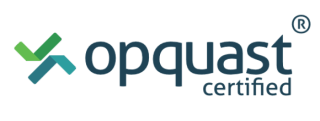The Opquast repositories and Clever Age are a love story that has lasted for several years. Many consultants have collaborated in writing them, and there are enough internal discussions for everyone to know what they are about.

Opquast Certified® Logo
In September 2015, Olivier announced on the Clever Age blog that each consultant could, if they wished, have access to the Opquast Certified® training platform. I just had time to get organized and I accepted his invitation last month.
Immediate feedback
I was surprised by the amount of information
I was already familiar with the Opquast checklists. I had used them for audit missions and I had even participated in the development of guidelines for a checklist dedicated to Web Performance. So I opened the “Web Quality” book thinking that I probably knew what was in it. Let’s be honest, I was wrong.
In addition to the label, there are explanations on the root causes of each of the best practices, its objectives, notes on how to validate it, and even anecdotes based on real-life cases. Reading the book was more interesting but also slower than I had imagined. My first piece of advice, then, if you want to take the certification: set aside some time to read with a clear head and take notes. The material is dense and deserves your attention.
The “training platform” is a full-featured MOOC
I was under the impression that the training platform will just be a series of small quizzes to get the hang of the checklist. It was a mistake. Of course, the little quizzes were there but also many articles about web quality, project management, user perception… which made me take a step back on the objectives and understand the more global context in which the web Quality is embedded.
I thought I could arrange myself several 15-minute sessions on the platform, but in fact, it’s better to reserve longer sessions of more than an hour and to challenge yourself to pass the certification in a limited time to be sure you don’t “slip” your training schedule.
I found the Opquast Certified® course exciting
I had three fears when I started the training:
- That the training would be limited to HTML best practices related to accessibility.
- That the rules are too simplistic, disconnected from reality.
- That it would contain, as is often the case in certifications, many things that are not directly relevant to my job.
Instead, the training does not impose its way of thinking but subtly puts forward relevant arguments, anchored in reality. It covers a wide variety of subjects without ever going too deeply into implementation details, without ever overwhelming the reader who would not feel concerned. Even better, the materials regularly emphasize the hindsight required to assess the relevance of the practices. In short, Opquast Certified® encourages reflection.
I realized how much it echoed my current position as a project manager. When talking about skills, you both need to be a jack of all trades but also to understand how the sausage is made, aka how a project is governed: with pragmatism and method, to achieve a goal that is rarely technical.
In fine
I think (and hope) that nowadays, the perception of Opquast Certified® is very good among front-end web developers. But this is not enough. Opquast Certified® is actually relevant for any profile that cares about user experience, at any level of the production chain. The technical requirements are very low but the certification is demanding and the exam is relatively difficult. So I think it will naturally become a benchmark for web investment by digital companies. We all have something to gain from it.
